
The United Church of Christ (UCC) is a mainline Protestant Christian denomination based in the United States, with historical and confessional roots in the Congregational, Calvinist, Lutheran, and Anabaptist traditions, and with approximately 4,800 churches and 773,500 members. The United Church of Christ is a historical continuation of the General Council of Congregational Christian churches founded under the influence of New England Pilgrims and Puritans. Moreover, it also subsumed the third largest Calvinist group in the country, the German Reformed. The Evangelical and Reformed Church and the General Council of the Congregational Christian Churches united in 1957 to form the UCC. These two denominations, which were themselves the result of earlier unions, had their roots in Congregational, Lutheran, Evangelical, and Reformed denominations. At the end of 2014, the UCC's 5,116 congregations claimed 979,239 members, primarily in the U.S. In 2015, Pew Research estimated that 0.4 percent, or 1 million adult adherents, of the U.S. population self-identify with the United Church of Christ.
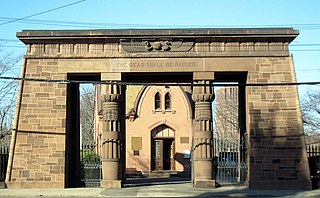
Grove Street Cemetery or Grove Street Burial Ground is a cemetery in New Haven, Connecticut, that is surrounded by the Yale University campus. It was organized in 1796 as the New Haven Burying Ground and incorporated in October 1797 to replace the crowded burial ground on the New Haven Green. The first private, nonprofit cemetery in the world, it was one of the earliest burial grounds to have a planned layout, with plots permanently owned by individual families, a structured arrangement of ornamental plantings, and paved and named streets and avenues. By introducing ideas like permanent memorials and the sanctity of the deceased body, the cemetery became "a real turning point... a whole redefinition of how people viewed death and dying", according to historian Peter Dobkin Hall. Many notable Yale and New Haven luminaries are buried in the Grove Street Cemetery, including 14 Yale presidents; nevertheless, it was not restricted to members of the upper class, and was open to all.
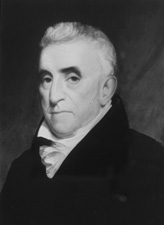
David Daggett was a U.S. senator, mayor of New Haven, Connecticut, Judge of the Connecticut Supreme Court of Errors, and a founder of the Yale Law School. He helped block plans for the first college for African Americans in the United States and presided over the conviction of a woman running a boarding school for African Americans in violation of Connecticut's recently passed Black Law. He judged African Americans not to be citizens and supported their colonization to Africa.
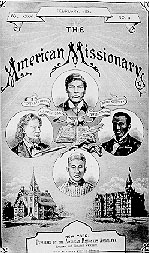
The American Missionary Association (AMA) was a Protestant-based abolitionist group founded on September 3, 1846, in Albany, New York. The main purpose of the organization was abolition of slavery, education of African Americans, promotion of racial equality, and spreading Christian values. Its members and leaders were of both races; The Association was chiefly sponsored by the Congregationalist churches in New England. Starting in 1861, it opened camps in the South for former slaves. It played a major role during the Reconstruction Era in promoting education for blacks in the South by establishing numerous schools and colleges, as well as paying for teachers.
The National Association of Congregational Christian Churches (NACCC) is an association of about 400 churches providing fellowship for and services to churches from the Congregational tradition. The Association maintains its national office in Oak Creek, Wisconsin, a suburb of Milwaukee. The body was founded in 1955 by former clergy and laypeople of the Congregational Christian Churches in response to that denomination's pending merger with the Evangelical and Reformed Church to form the United Church of Christ in 1957.
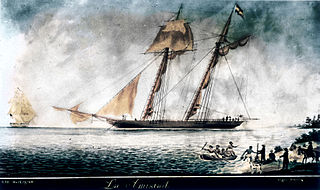
La Amistad was a 19th-century two-masted schooner, owned by a Spaniard colonizing Cuba. It became renowned in July 1839 for a slave revolt by Mende captives, who had been captured and sold to European slave traders and illegally transported by a Portuguese ship from West Africa to Cuba in violation of existing European treaties against the Atlantic slave trade. Two Spanish plantation owners, Don José Ruiz and Don Pedro Montes, bought 53 captives, including four children, in Havana, Cuba, and were transporting them on the ship to their plantations near Puerto Príncipe. The revolt began after the schooner's cook jokingly told the slaves that they were to be "killed, salted, and cooked." Sengbe Pieh, a Mende man, also known as Joseph Cinqué, unshackled himself and the others on the third day and started the revolt. They took control of the ship, killing the captain and the cook. In the melee, three Africans were also killed.

The Windsor Avenue Congregational Church is historic church at 2030 Main Street in Hartford, Connecticut. The brick Romanesque Revival-style church building, completed in 1872, now houses the Faith Congregational Church, whose lineage includes the city's oldest African-American congregation, established in 1819. The church is a stop on the Connecticut Freedom Trail and was listed on the United States National Register of Historic Places in 1993.
Broadway United Church of Christ is a Congregationalist Church located on West 86th Street, between Broadway and West End Avenue on the Upper West Side of Manhattan.
These congregations are affiliated with one of the five associations comprising the Heartland Conference of the United Church of Christ. They are listed in order of association.
Dixwell is a neighborhood of New Haven, Connecticut. Named for Dixwell Avenue, the main thoroughfare of the neighborhood which in turn was named for regicide judge John Dixwell, it is situated generally northwest of and adjacent to Downtown New Haven.

Rev. Joshua Leavitt was an American Congregationalist minister and former lawyer who became a prominent writer, editor and publisher of abolitionist literature. He was also a spokesman for the Liberty Party and a prominent campaigner for cheap postage. Leavitt served as editor of The Emancipator, The New York Independent, The New York Evangelist, and other periodicals. He was the first secretary of the American Temperance Society and co-founder of the New York City Anti-Slavery Society.
Andrew Thompson Judson was a United States representative from Connecticut and a United States district judge of the United States District Court for the District of Connecticut.

The Mount Carmel Congregational Church and Parish House is a historic church complex at 3280 and 3284 Whitney Avenue and 195 Sherman Avenue in Hamden, Connecticut. It consists of an 1840 Greek Revival church with a tetrastyle temple front portico, and a 1911 Colonial Revival parish house. A non-contributing 1925 sexton's house is also on the property. The church is considered to be Hamden's finest example of Greek Revival architecture, and the parish house one of its finest Colonial Revival houses. The property was listed on the National Register of Historic Places in 1991.

The Whitneyville Congregational Church, now the Whitneyville United Church of Christ, is a historic Congregational Church at 1247-1253 Whitney Avenue in the Whitneyville section of Hamden, Connecticut. The congregation is now affiliated with the United Church of Christ (UCC). The church building is a Greek Revival style built in 1834, with an interior altered in 1866 to designs by Rufus G. Russell. The church, along with its 1924 parish house, was added to the National Register of Historic Places in 1995 for its architecture.
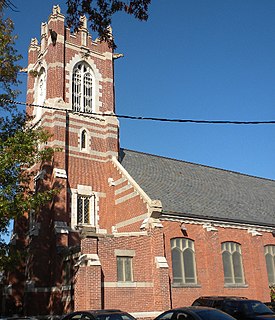
St. Luke's Episcopal Church is a historic church at 111-113 Whalley Avenue in New Haven, Connecticut. Built in 1905 for a congregation founded in 1844, it is a good example of late Gothic Revival architecture, and is further notable as the second church in the city established as an African-American congregation. It was listed on the National Register of Historic Places in 2003.

Trowbridge Square Historic District, originally known as Village of Spireworth and Mount Pleasant, is a well-preserved 19th-century neighborhood in the Hill section New Haven, Connecticut. Roughly bounded by Columbus, Howard, and Union Avenues, and Church Street on the east, the area was laid out in 1830 and developed as a working-class neighborhood. It retains its historic streetscape, and many original buildings, representing modest versions of a diversity of mid-to-late 19th century styles. The district was listed on the National Register of Historic Places in 1985.

First Congregational United Church of Christ is a historic church at 700 Poyntz Avenue in Manhattan, Kansas. It is listed on the National Register of Historic Places as First Congregational Church.
Simeon Jocelyn (1799-1879) was a white pastor, abolitionist, and social activist for African-American civil rights and educational opportunities in New Haven, Connecticut, during the 19th century. He is known for his attempt to establish America's first college for African Americans, in New Haven, and for his role in the Amistad affair.

The Amistad Research Center (ARC) is an independent archives and manuscripts repository in the United States that specializes in the history of African Americans and ethnic minorities. It is one of the first institutions of its kind in the United States to collect African American ethnic historical records and to document the modern Civil Rights Movement.

The Canterbury Female Boarding School, in Canterbury, Connecticut, was operated by its founder, Prudence Crandall, from 1831 to 1834. When townspeople would not allow African-American girls to enroll, Crandall decided to turn it into a school for African-American girls only, the first such in the United States. The Connecticut legislature passed a law against it, and Crandall was arrested and spent a night in jail, bringing national publicity. Community violence forced Crandall to close the school.
















